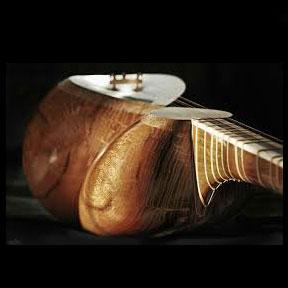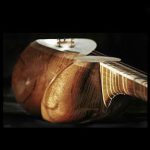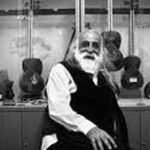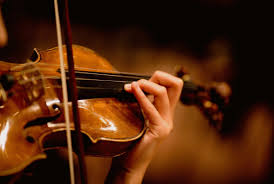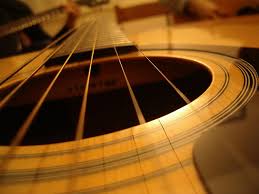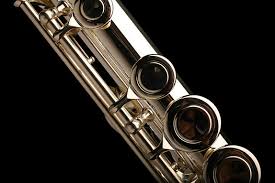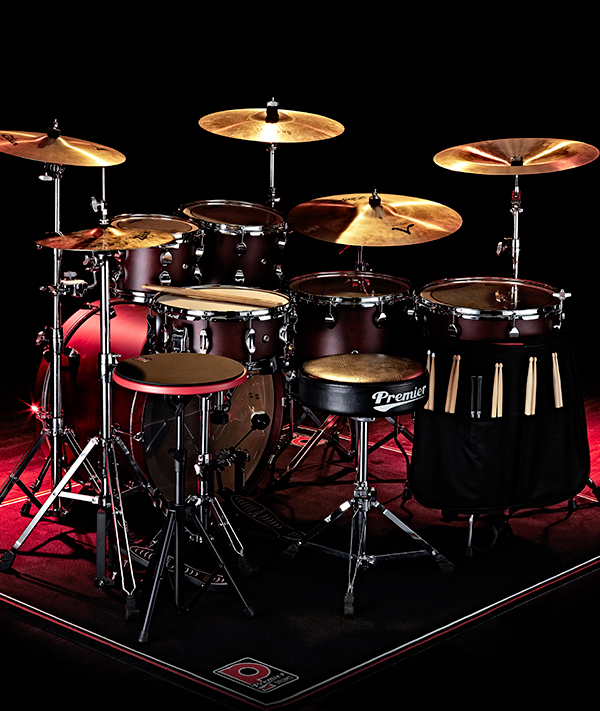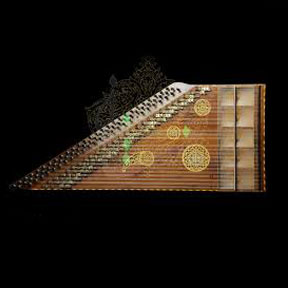History
The tar is a fretted plucked string instrument made from wood, skin, bone, gut, and metal, with an overall length of about 95 centimeters. Although there is no mention of it in ancient texts, for about two hundred years, the tar has been one of the main instruments in Iranian music. The Iranian tar player, while sitting, holds the tar horizontally on the thigh so that the neck of the tar is on the left side and the resonator (soundbox) on the right side of the player. The player moves the fingers of the left hand on the frets along the neck of the tar and plucks the strings with a plectrum held in the right hand.
Physical Structure
Resonator (Soundbox): The resonator is carved from a single piece of wood and consists of two hollow, nearly pear-shaped chambers, one larger and the other smaller. The larger part is called the “kaseh” (bowl), and the smaller one is called the “naqareh.” The open ends of the kaseh and naqareh are covered with skin, and the bridge is placed on the skin of the kaseh. The wood used for the resonator is usually from the mulberry tree.
Skin: The skin of the tar is selected from the thin hide of quadrupeds like goats or lambs.
Bridge: The bridge is usually made of bone and is placed on the soundbox with two small legs, measuring approximately 5 centimeters in length and 2 centimeters in height. The strings pass individually through shallow grooves on the surface of the bridge.
Neck: The neck of the tar is made of hard woods like walnut or mulberry and is a solid tube approximately 50 centimeters long and 4 centimeters in diameter. The front of the neck is flat, and the back is semi-circular, with frets tied at specific intervals. On both sides of the neck, strips of bone are inlaid, adding to the aesthetic of the instrument and preventing the wood from wearing out due to frequent finger contact. The neck of the tar is connected to the naqareh at one end and the headstock at the other.
Headstock: The headstock, or tuning box, is a small hollow box at the top of the neck, made from the same wood as the soundbox. It has six tuning pegs corresponding to the six strings of the tar.
Tuning Pegs: The tar has six wooden tuning pegs, shaped like thick-headed nails. The part of the peg used for tuning is wider and located outside the headstock, while the thinner part, around which one end of the string is wound, is inside the hollow space of the headstock.
Nut: The nut is a narrow, low bone piece placed between the neck and the headstock. It has shallow grooves through which the strings pass on their way to the tuning pegs.
Frets: The tar typically has 28 frets made from gut or nylon. Each fret is tied around the neck in three or four loops and then knotted, with the knots placed in a groove on the upper surface of the neck. The position of the frets is not fixed and can be slightly adjusted for different musical modes.
Tailpiece: The tailpiece is a small piece of wood or bone attached to the end of the soundbox, with grooves where the twisted or knotted ends of the strings are secured.
Strings and Material: The Iranian tar has six metal strings of varying thicknesses. Typically, the first and second strings (white metal) are 0.18 to 0.20 mm thick, and the third and fourth strings (yellow brass) are 0.18 to 0.22 mm thick, tuned in unison. The fifth string (white metal) is of a smaller diameter and tuned in unison with the first and second strings. The sixth string (yellow metal) is a bass string with a diameter of 0.38 mm, tuned one octave lower than the first and second strings.
Range: The tar has a typical sound range of nearly three octaves.
Tuning: The six strings of the tar are tuned in descending fourths and octaves. The tuning can be adjusted based on the player’s needs, and for performing the twelve traditional modes of Iranian music, the tuning of the fifth and sixth strings may vary.
Notation: The tar is notated using the treble clef (G clef).
Plectrum: The plectrum is a metal piece, usually made of brass, approximately 3 to 4 centimeters long. Half of its length, which the player holds, is covered with wax.

